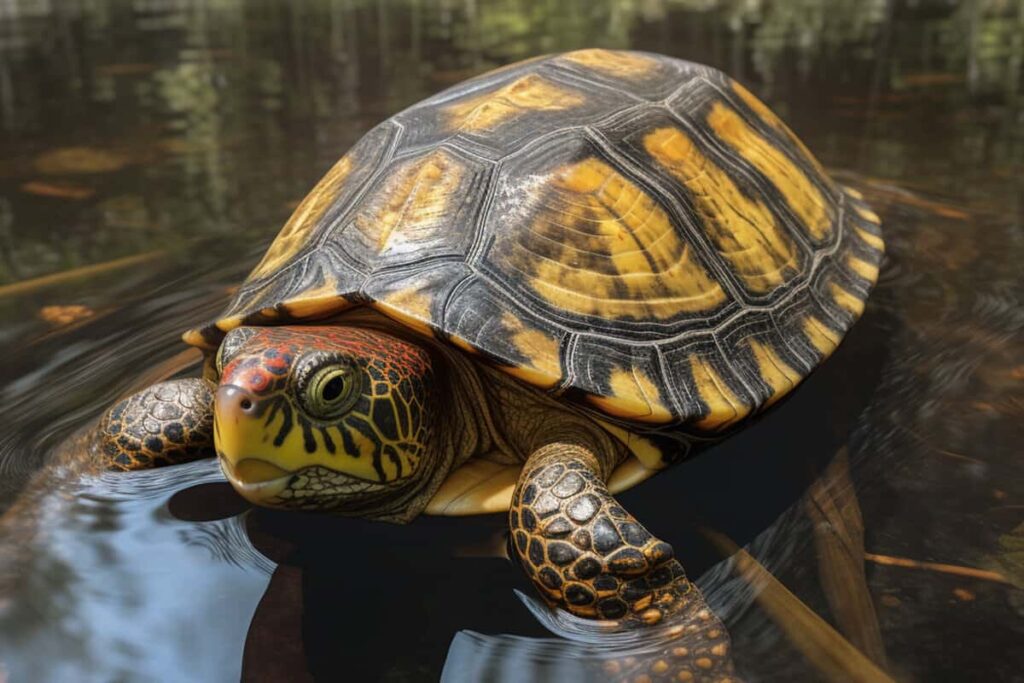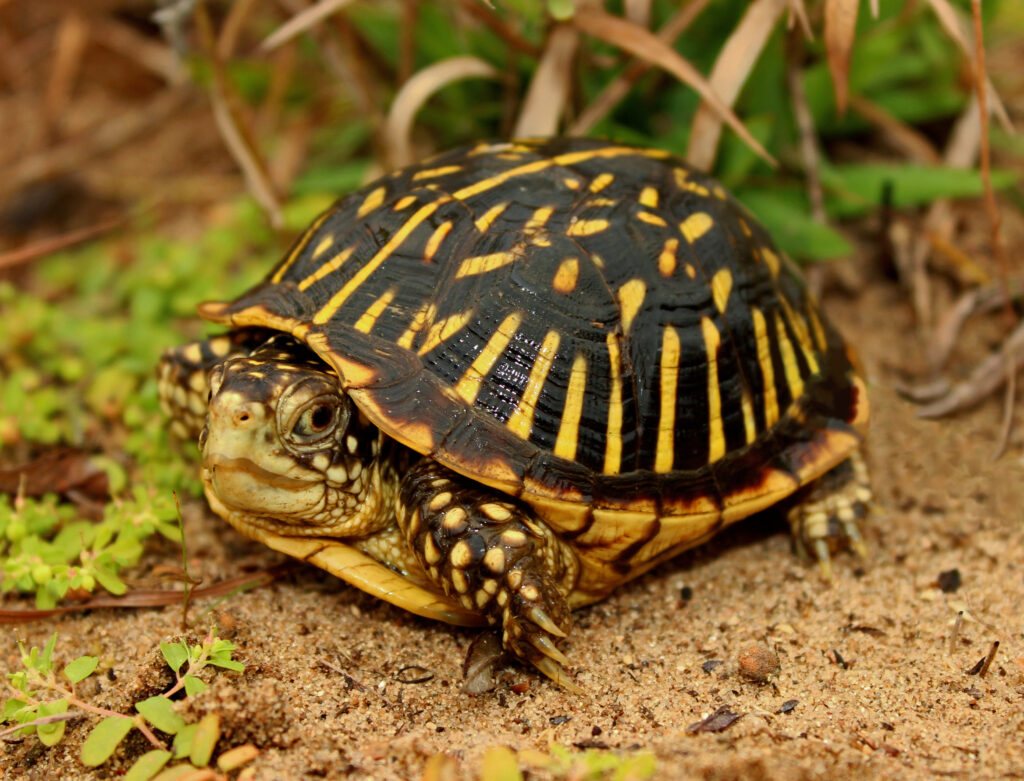Table of Contents
ToggleIntroduction
Box turtles are a charismatic representative of the chelonioid world, fascinating observers with their distinct appearance and unusual habits. Can Box Turtles Swim? Whether or not they can swim is only one of the mysteries surrounding these hardy organisms. We find ourselves on a quest to unravel the mystery of the box turtle’s complex relationship with water.
Box turtles are well-known for their terrestrial lifestyle due to their distinctive domed shells and elaborate designs. The curiosity concerning these reptiles’ swimming skills is piqued, however, by their odd sightings near water sources.
Natural Habitat And Behavior
Terrestrial Lifestyle: Box turtles, symbolic members of the Chelonian family, are primarily terrestrial creatures. Their habitats range from woodlands and grasslands to meadows, where they exhibit a distinctive terrestrial lifestyle. These turtles are well-adapted to navigating diverse landscapes with their sturdy limbs and unusual. Hinged shells that can close tightly to protect against predators.
Occasional Encounter with Water: Box turtles are predominantly terrestrial but occasionally encounter water sources in their natural habitats. These water sources may include ponds, streams, or shallow puddles. During extreme heat or dry spells, box turtles may seek refuge near water to prevent dehydration. Demonstrating a strategic use of aquatic environments to supplement their terrestrial lifestyle.
Limited Swimming Ability: Box turtles aren’t aquatic like their relatives and could be better swimmers even when wet. Their physical adaptations, with a somewhat tall, dome-shaped body and land-based rather than underwater appendages., contribute to limited swimming ability. While box turtles can navigate shallow water and float partially, they lack construction for sustained or deep-water swimming.
Physical Adaptations

Shell Structure: The iconic feature of box turtles is their unique shell, characterized by a high, domed structure hinged at the bottom. This distinctive shell design provides them with exceptional protection against predators. However, the box turtle’s shell can pose challenges when it comes to swimming. The shell’s domed shape and limited flexibility make it more suited for terrestrial life. Restricting its streamlined movement in water compared to more aquatic turtle species.
Limb Anatomy: Box turtles’ limb anatomy fits the terrestrial locomotion bill. Their limbs are sturdy and well-suited for walking on various terrains. While they may paddle or move their limbs in a manner that allows some buoyancy in water, box turtles lack the webbed feet and streamlined limbs characteristic of turtles with a more aquatic lifestyle. This limb anatomy contributes to their limited swimming ability, as their movements in water are not as efficient as those of fully marine species.
Respiratory Adaptations: Box turtles exhibit respiratory adaptations that align with their predominantly terrestrial lifestyle. Unlike fully aquatic turtles that can extract oxygen from water through specialized respiratory structures, box turtles rely on lungs for breathing. When submerged in water, box turtles must come to the surface to breathe, limiting their time underwater. This respiratory adaptation further emphasizes their terrestrial orientation and adds to the understanding of their constrained swimming capabilities.
Swimming Incidents
Observations in the Wild: Observations of box turtles engaging with water in their natural habitats provide valuable insights into their occasional swimming incidents. In the wild, box turtles may fit the bill wading through shallow water, utilizing these environments for drinking, cooling off during hot weather, or seeking refuge. While these observations illustrate their ability to navigate water, they also emphasize the limited and deliberate nature of their swimming activities.
Captivity Experiences: In captivity, where environmental conditions have control, box turtles may interact more frequently with water. Some turtle enthusiasts provide shallow water features in enclosures to mimic natural conditions and offer opportunities for the turtles to hydrate and engage in mild aquatic activities. However, even in captivity, box turtles typically exhibit a cautious approach to water, reflecting their terrestrial instincts.
Anecdotal Evidence from caretakers and researchers contributes additional perspectives on box turtles and their swimming behaviours. Caretakers often report box turtles entering water dishes or shallow ponds within their enclosures. However, these anecdotes highlight the variability among individual turtles, with some displaying a more pronounced interest in water than others. Anecdotal Evidence, while informative, underscores the importance of recognizing the diversity in behaviour among box turtles.
Limitations And Considerations
Swimming Capacity Varies: Acknowledging the variability in swimming capacity among individual box turtles is crucial. While some may demonstrate a degree of comfort and ability in water, others may exhibit more reluctance or limited swimming prowess. Factors such as age, health, and individual temperament contribute to this variability. Recognizing and respecting these differences is essential when considering the interaction of box turtles with aquatic environments.
Stress Factors: Swimming, even briefly, can be a source of stress for box turtles. While they may navigate shallow water for specific purposes, prolonged exposure or forced swimming can lead to stress. Stress factors include disruptions to their natural behaviour, changes in environmental conditions, or exposure to unfamiliar stimuli. Caretakers should be mindful of these stressors and provide environments that prioritize the well-being and comfort of box turtles.
Importance of Monitoring: Regular monitoring is paramount, given the diverse responses of box turtles to water. Caretakers and researchers should observe the behaviour of box turtles when they encounter water, noting any signs of stress or discomfort. Monitoring allows for a better understanding of individual preferences and informs adjustments in habitat design or management practices to cater to the specific needs of each turtle. Careful observation also aids in the early detection of potential health issues related to swimming activities.
Case Studies
Box turtles do best in places where they can swim: A lot of interesting information has figured out the connection between box turtles and water settings through case studies. In some places, box turtles have taken note of doing very well in areas with lots of water, showing a surprising preference for swimming. These examples show that box turtles can live in various environments, which goes against the common belief that they only live on land.
Problems because of water: On the other hand, case studies also show the problems and challenges that box turtles may face in water-related situations. When box turtles get into deep or fast-moving water, they can have problems and sometimes bad things happen. Box turtles usually stay on land, which means they may be more likely to be hurt by water-related things. It shows how important it is to know their limits in water settings.
Conclusion
Box turtles‘ native environment and behaviour, defined by a largely terrestrial lifestyle with infrequent interactions with water, lay the groundwork for understanding their swimming ability. Physical adaptations, ranging from the characteristic shell structure to limb architecture and respiratory adaptations, shed light on the restrictions that limit their movement in aquatic habitats.
Whether witnessed in the wild, in captivity, or through anecdotal Evidence, swimming occurrences provide insights into box turtles’ complex relationship with water. These occurrences highlight the reptiles’ selected aquatic interactions, demonstrating their thoughtful and cautious approach while navigating watery terrain.







